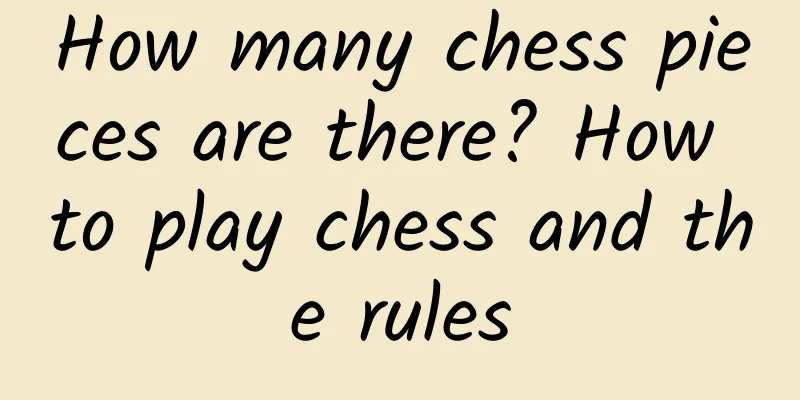How many chess pieces are there? How to play chess and the rules

|
Today, for friends who like chess, you can have a good time! Encyclopedia Knowledge today specifically shares with you how to play chess, how many chess pieces are there, how to play chess and the rules, what are the conditions for the king-rook castling in chess? Learn more about common knowledge about chess. Contents of this article 1. How many chess pieces are there? 2. How to play chess and its rules 3. What are the conditions for castling in chess? 1How many chess pieces are there?The black and white sides each have 1 king, 1 queen, 2 bishops, 2 knights, 2 chariots, 8 soldiers, and 16 chess pieces each. The chessboard is square, consisting of 64 black and white squares, and the chess pieces are divided into black and white. It originated in Asia and was later introduced to Europe by Arabs. It has become an internationally popular chess game and is also an intellectual competitive sport. It was once listed as an official event in the Olympic Games. The purpose of a chess game is to checkmate the opponent's king. The rules of the game state that when the king of one side is attacked by the opponent's chess piece, the king is checked, and the attacking side is called "check". At this time, the attacked side must immediately "respond to the check". If the check cannot be avoided, the king is checked, and the "check" side wins the game. 2How to play chess and the rulesThe arrangement is as follows: Taking the player's self-service perspective as an example, the innermost ones are: chariot, horse, elephant, queen, king, elephant, and chariot, and the outer row is all soldiers. The specific rules are as follows: 1. King: The king can move horizontally, vertically, or diagonally, but can only move one step at a time. Except when castling, the king can move to any adjacent square that is not attacked by the opponent's pieces. 2. Queen: You can move horizontally, vertically, or diagonally, with no limit on the number of steps, but you cannot jump over other pieces. 3. Rook: Can move horizontally or vertically, with no limit on the number of steps; cannot move diagonally, and cannot jump over other pieces except by castling. 4. Elephant: It can only move diagonally, with no limit on the number of squares, and cannot jump over other pieces. At the beginning of the game, each side has two elephants, one occupying a white square and one occupying a black square. 5. Horse: In each move, the player first moves one square horizontally or vertically, and then moves one square diagonally outwards, or first moves one square diagonally, and then moves one square horizontally or vertically outwards, to advance across the board. 6. Pawn: It can only move forward straight, one square at a time. But when taking the first step, it can move one or two squares. The way a pawn captures pieces is different from the direction of movement. It moves straight and captures diagonally. That is, if there is an opponent's piece within a square that the pawn moves diagonally to, it can capture it and occupy that square. 3What are the conditions for castling in chess?1. The king and the castled rook cannot be moved. 2. There cannot be any chess pieces between the king and the rook. 3. The king cannot be checked. 4. The route that the king passes through cannot be checked. 5. The king's final position cannot be checked. |
<<: How to play Chinese chess well? How to break the palace cannon in chess
Recommend
Menstrual disorders will show two bars
Today's young people do not have to neglect w...
What are the common gynecological diseases?
We all know that women's body structure is pa...
Does cervical nabothian cyst require surgery?
Female friends should pay attention to the mainte...
Why do I feel backache and buttocks pain during pregnancy?
Pregnancy is both a happy and painful thing. The ...
Why does vaginal gas occur?
Most women will definitely find that there is gas...
How much does AirPods Pro cost? When will the new AirPods Pro be released?
AirPods Pro is a new headset that Apple is about ...
What is the BGM of the Korean drama Vagabond? Vagabond background music OST summary
After the first two episodes of the Korean drama ...
How to lose weight during pregnancy without hurting the baby?
Pregnancy is a special period for women. If you a...
Reasons why women's leucorrhea turns yellow and stringy
Girls are a relatively special group, because if ...
Lochia discharge during normal delivery
The process from pregnancy to childbirth is a lon...
Leucorrhea with blood after menstruation
Leucorrhea with blood after menstruation is a sym...
What to do about menopausal endocrine disorders
In fact, health preservation has been deeply root...
Is endometritis serious?
There are many types of gynecological diseases, a...
Women with these factors may be "targeted" by ovarian cancer! Learn these tips to prevent it
Ovarian cancer, breast cancer and uterine cancer ...









